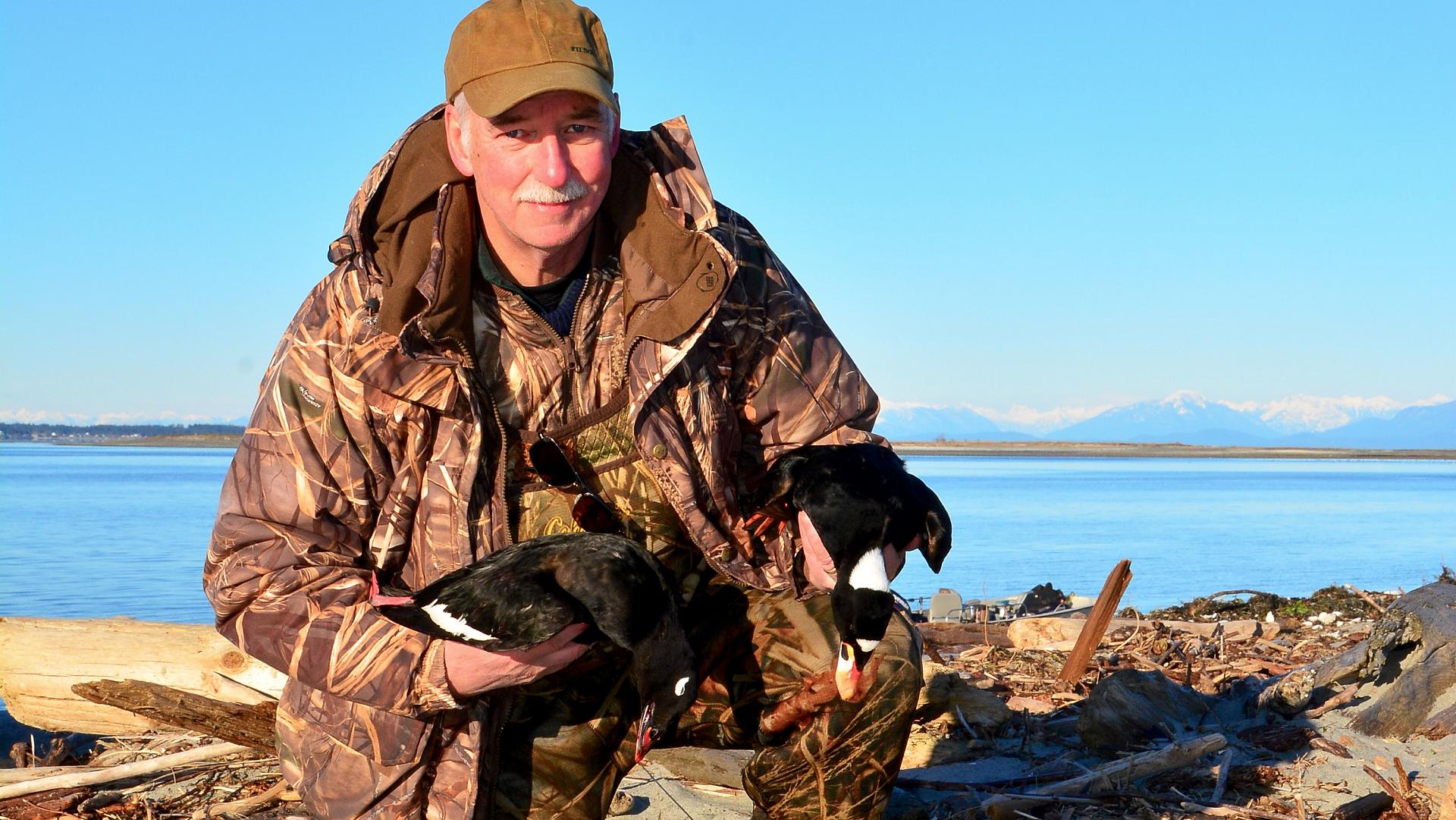Birds of a different feather
Colourful ducks offer a unique and challenging hunt amid rugged coastal beauty
Advertisement
It’s January 2, 2017, and I’m sitting on a gravel spit off Tree Island, north of Denman Island near the entrance to Vancouver Island’s Comox Harbour. Overhead, the familiar yellow of a Canadian Armed Forces search-and-rescue aircraft circles the harbour in an apparent training exercise, a stark reminder that mistakes in this environment can cost you everything in minutes.
The temperature’s hovering right around freezing, there’s a moderate breeze and the choppy ocean swells are releasing a mist that covers everything, including me. This is cold-to-the-bone hunting, but I’m prepared for it—I’m wearing several layers, neoprene waders, a warm, water-repellent hat and waterproof gloves. Fortunately, there’s little cloud cover and the sun is warming my face as I sit in anticipation, waiting for the first flight of sea ducks to swing over the blocks.
Advertisement
The tide was at its highest at first light, and it’s been receding throughout the day, slowly exposing new ground from beneath the swells. I check my watch. It’s 2:30 p.m. In 12 hours, the spit I’m sitting on will have again disappeared beneath the waves.
From my vantage point, I can make out several species of sea ducks bobbing on the dark waters of the harbour. Surf, black and white-winged scoters are here, as are clown-coloured harlequins and striking long-tailed ducks. One minute they’re riding a swell, the next they’re gone. It appears they’re feeding, as I periodically see them diving and few are flying. What I do see on the wing are mallards, bufflehead and common goldeneyes, but I’m not here for those species, which I can hunt back home in Alberta. As I look north, I can also make out the unmistakeable profile of skeins of brant trading across the open water in the distance, but there’s no open season for those iconic birds here.
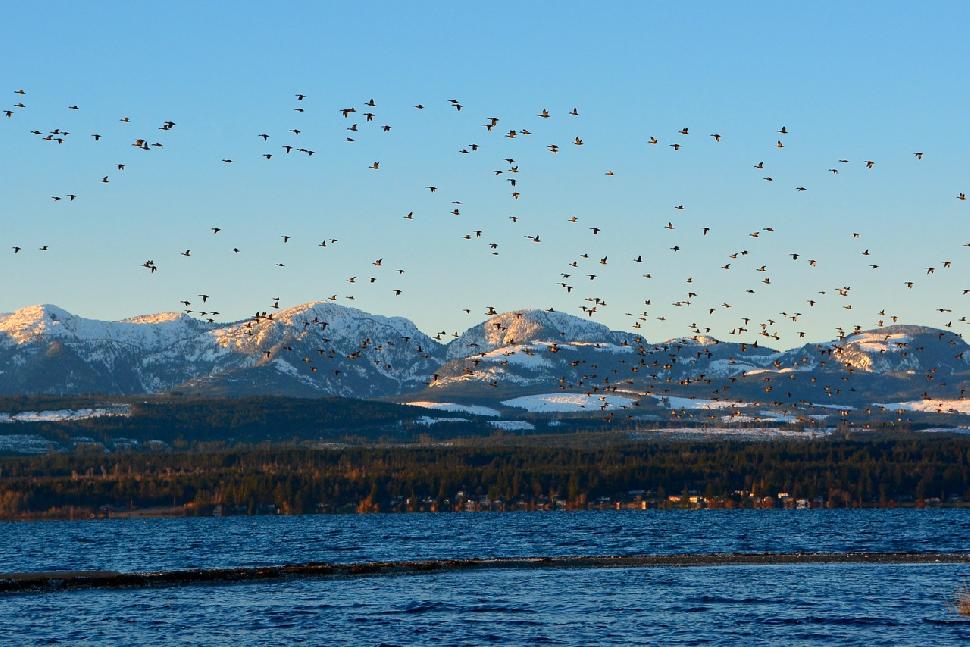
Vancouver Island’s tidal waters are rugged and beautiful
Patience is paramount for waterfowlers in any environment, but perhaps never more so than when hunting sea ducks. But patience is easy in this wondrous seascape. Behind me, on the mainland, snow-capped mountains gird the urban development along the shore, while out front, forested islands stand sentinel, gatekeepers to the mysteries of the Strait of Georgia. For a prairie boy like me, the view never gets old.
Advertisement
Eventually, my perseverance pays off and a small flight of white-winged scoters skirts the outer edge of the short line of decoys. I rise and swing, focused on the drake at the head of the line. At the report, I see a bird tumble into the water, but it’s not the drake I’d targeted. It’s a hen that goes down, two birds behind the drake in the string of five, a vivid reminder that large-bodied sea ducks are often farther away and flying more quickly than they appear. And the open saltchuck offers little in the way of benchmarks to help gauge distance and speed.
Thirty metres farther up the spit, my host, Len Everett, rises from where he’d been reclining against a log. “We’d better get the boat.” he says matter-of-factly. “That scoter isn’t dead, and they can cover a lot of water when wounded.”
We quickly clamber into Len’s Boston Whaler, push off the beach and motor toward where we last saw the bird dive. This is no place for a retriever, with the cold water and extended distances making for a lethal combination. I scan the grey waters and spot a blob floating in the swells 100 metres ahead, so I point Len in its direction. By the time we get there, the bird is floating lifeless and I use a long-handled fishing net to scoop it into the boat—my first-ever sea duck.
I manage to drop a second white-winged scoter later on that first afternoon of our two-day hunt, and fortunately it falls stone dead. I then found a way, however, to gas shots on successive pairs of long-tailed ducks that cruised the outer reaches of our blocks. It’s not an auspicious sea duck-hunting debut by any measure, but Len had given me fair warning that day one is typically a humbling experience for first-timers.
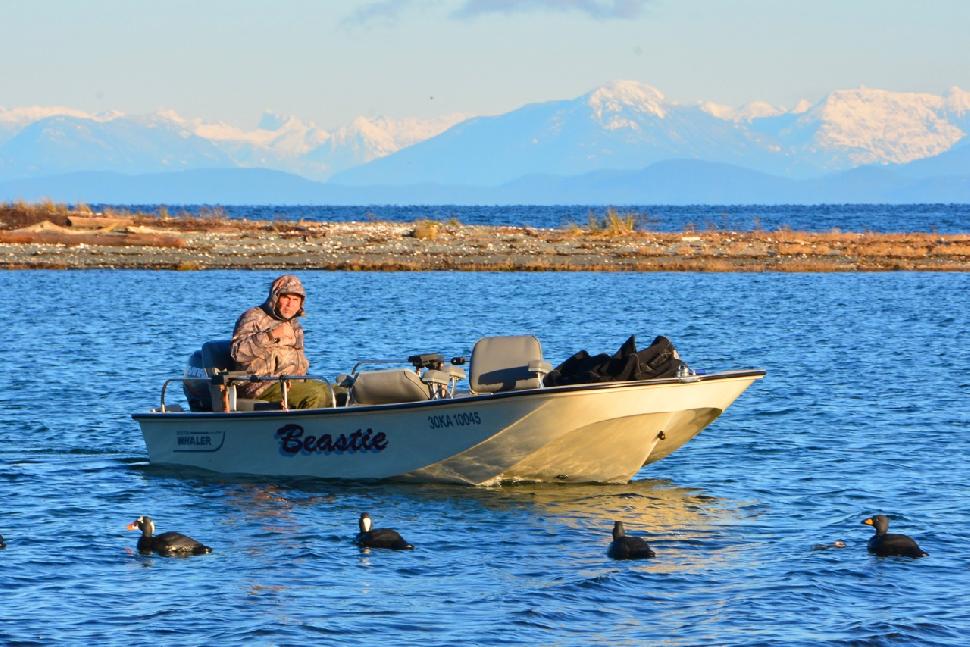
Len Everett sets out the decoys
On day two, Len and I headed out with a renewed optimism that was almost immediately rewarded. Shortly after first light, we motored to the middle of the harbour, shut down the engine and let the boat drift with the current. Behind us, a dozen decoys on a long line obediently followed. There, out on the open water, our quarry would be long-tailed ducks and harlequins.
The longtails were highly visible, sprinkled like grains of salt on the grey water of the harbour, but the colourful harlies appeared to be scarce. There’s surprisingly few of them to be seen in the harbour these days, Len told me, adding that he’s concerned nobody seems to care, or ask why. Perhaps they’ve simply moved to other more productive waters, or it could be they’re truly on the decline. In the greater Comox Valley area, where Len has hunted most of his life, he believes the numbers of sea ducks overall are down over the long term, with no appreciable recent increases (see “The sea duck situation,” below).
Long-tailed ducks seldom venture near the islands or mainland, preferring the security of open water, and at least one flight, distracted by our decoys, showed little concern for our boat. As they cut through our line, I rose and swung ahead of the first bird, a beautiful full-plumage drake, and watched it splash down out of the corner of my eye as I searched for a second target.
Banking hard, two more drakes turned downwind to escape. I pushed the barrel out in front of the lead bird, squeezed the trigger and it also splashed down at the report. We collected both ducks in short order, and it was the first time I’d ever held these spectacular birds in my hands. I was somewhat surprised by how small-bodied they were—almost dainty given the vast, brutish habitat they prefer.
After that first successful volley, the action quieted significantly. In response, we moved around the harbour, setting up in several different locations, both on the open water and on a series of small islands. With little wind to encourage them, however, the birds just weren’t moving.
Early in the afternoon, Len beached us on an island where he’s historically had success. It was relatively long and serpentine, with cobbled and sandy shores littered with driftwood of all shapes and sizes. On those points that remained above water even at high tide, withered grasses and a few wind-buffeted trees eked out a meagre existence. And here and there, watchful bald eagles perched on the driftwood.
We strung out two dozen scoter blocks and a sprinkling of goldeneyes in the open water about 25 metres offshore, then leaned back against a beached log. We were hoping the birds would become a little more active, and we didn’t have to wait long. A flight of surf scoters arrived first, and I pulled a stunning drake from the mix. In breeding plumage, these are hefty, striking ducks, with velvet-black bodies contrasted against a nape and forehead of snow white. Then there are their oversized rosy-pink webbed feet and their broad bill, with its beautiful palette of yellow, orange, white and black. From afar, they may look homogenously dull and dark, but in the hand, they’re as brilliantly coloured as any duck I’ve seen.
Graciously, Len pushed off to retrieve my downed surf scoter before it could drift too far, leaving me to continue my vigil from shore. And just about the time he slowed down to scoop up the bird, another small skein of white-winged scoters rounded the bend of an adjacent island, clearly hell-bent for the decoys. As I rose and swung my gun to get out in front of them, the birds turned and gained speed, making for the safety of open water. By then I was becoming more accustomed to judging the speed and distance of these ducks and I shot twice with more confidence than I ought to have, dropping two birds in quick succession. My timing was perfect, and Len was able to pick them up on his way back.
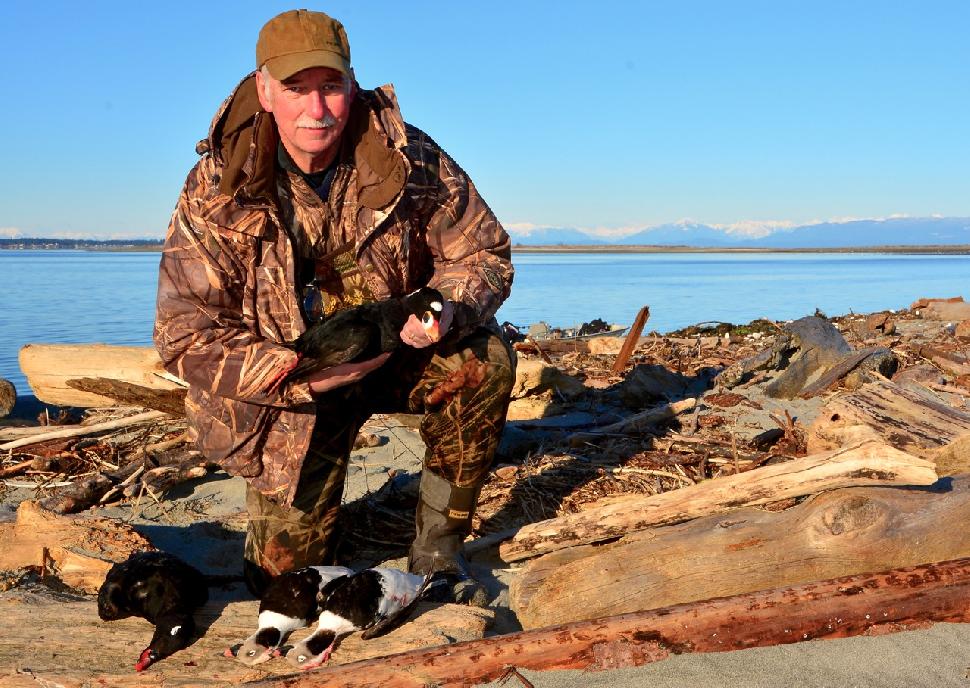
The author holds a surf scoter; at his feet lie a white-winged scoter and two longtails
Over the next couple of hours, flock after flock of scoters—both surf and white-winged—cruised through to examine our decoys. But with several birds in hand, I didn’t want to shoot another scoter unless it was an elusive black, as I still hadn’t taken a harlequin and didn’t want to risk limiting out before I had that opportunity.
With time on our hands, Len spoke of growing up in the Comox Valley, where he hunted and fished all his life. He once even guided John Wayne—the Duke himself—for salmon. But times have changed in the valley. While recreational fishing remains popular, Len says the culture of sea duck hunting has all but disappeared. That was clearly in evidence, as we were the only hunters on the water.
With only an hour to go until sundown, we decided to pack up and move once again. We motored back out to the open water and dropped our decoy rig, once again adrift on the swells. It would be our last chance to find harlies; failing that, perhaps we could fool more long-tailed ducks.
Sure enough, we hadn’t been in place long before a squadron of a half-dozen longtails broke from their flight path and veered toward our decoys. It was decision time. If I took a couple of those birds, I’d be limited out, meaning I’d go home without a harlequin. On the other hand, if I didn’t shoot, I could easily be squandering the final opportunity of our hunt.
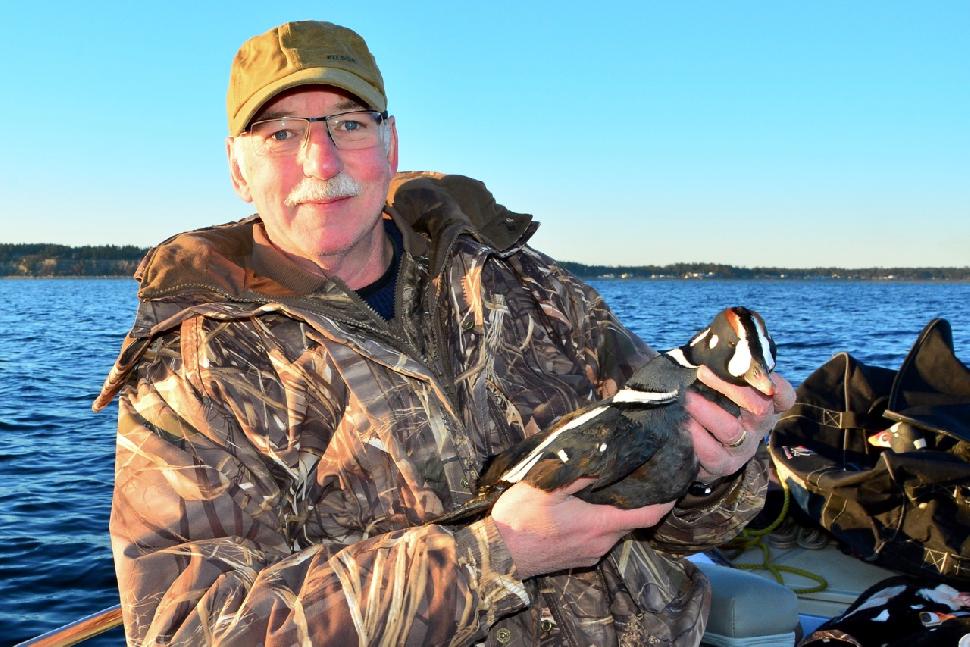
The author and his coveted harlequin
In the end, it was an easy decision. I hadn’t come here to shoot bag limits, but rather to experience everything that West Coast sea duck hunting has to offer. So, I let the longtails swing unmolested through the blocks, content to take a pass on the easiest shots of the day.
Hunting can be fickle. Sometimes you’re treated like a prince, other times you’re clearly a pauper, worthy of little more than disdain. And there’s simply no predicting which way it will go on any given day. But on that day, hunting the most majestic of all waterfowl on the dark waters of Comox Harbour, I was treated like royalty. Not two minutes after I passed on the longtails, three harlequins—two drakes and a hen—appeared out of nowhere, their dark blue plumage near invisible as they winged toward us just a metre or so above the swells.
Len’s trained eyes spotted them first, and at his alert I reacted on instinct. Quickly picking out the drakes, I shot twice. Only one splashed down, however, and the remaining drake and hen wheeled safely away, quickly disappearing against the backdrop of the harbour. Just as well, I figured, knowing the pair will help ensure new generations of sea ducks will continue to trade across the grey, misty skies of Comox Harbour.
The sea duck situation
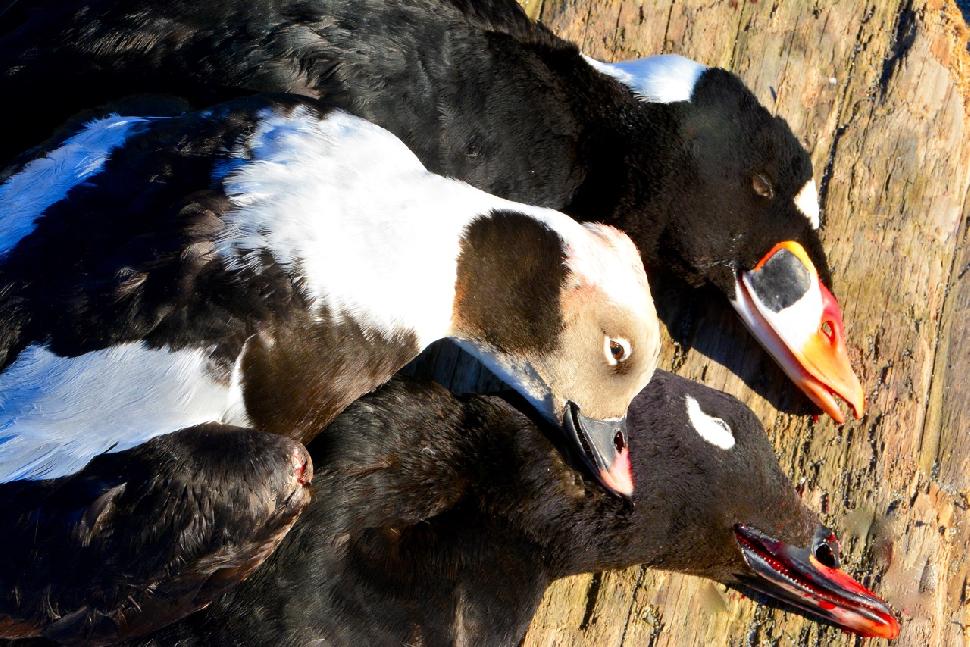
Waterfowl biologists recognize 15 species of North American sea ducks: four eiders, three scoters, two goldeneye and three mergansers, as well as the bufflehead, harlequin and long-tailed duck. The term “sea duck” is somewhat of a misnomer, as not every species in this taxonomically distinct tribe of waterfowl necessarily live in coastal marine habitats. In fact, some are essentially freshwater birds throughout most of the year, and waterfowlers in even the most landlocked regions of Canada will be familiar with several of them.
Putting aside what the scientists say for a moment, waterfowl hunters think of eiders, scoters, harlequins and long-tailed ducks when they talk about sea ducks. That’s because you need to be in a coastal or estuarine habitat to hunt these birds.
Eider hunting in Canada is restricted to the East Coast. Although there’s a significant breeding population of eiders in the western Arctic, they typically winter off Alaska and seldom venture into accessible Canadian waters. Scoters can be hunted on either the Atlantic or Pacific coasts, as can long-tailed ducks, which also winter on the Great Lakes, where they can be hunted. Although present on both coasts, harlequins can only be hunted legally on the Pacific side.
When compared with dabblers and pochards (canvasbacks, redheads, ring-necked ducks and scaup), very little is known about the population status of sea ducks. They typically breed in remote areas and, as such, they’re poorly monitored and poorly understood. Historically, we’ve seen a decline in sea duck populations overall, although the data suggests most populations are currently stable or slightly increasing. Frankly, the lack of reliable data collected over a period of time makes most population estimates unreliable.

